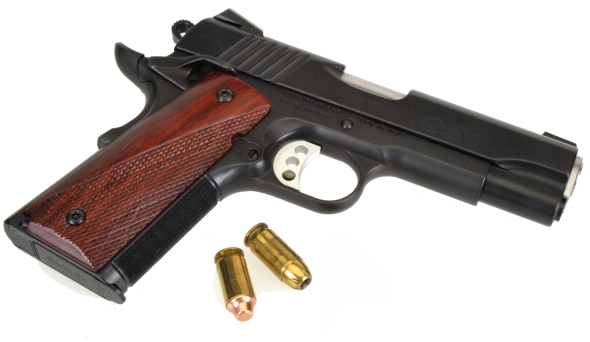
Changing over from handloading a 58 round per pound 378 Weatherby Magnum to the 45 Auto at 1,400 rounds per pound is interesting. Care in handloading is always required, however, large capacity rifle cases have greater latitude. Handloading for pistols can be quite critical, as they normally operate with small charges of fast burning powder at modest pressures. Overshooting a 120 grain magnum charge by 1 grain is an 0.8% metering error where a 1 grain increase in a 5 grain pistol charge is a 20% metering error. Depending on bullet weight an powder type, the rifle would see a pressure increase of approximately 1,500 PSI , while the pistol pressure would increase by approximately 7,000 PSI. Additionally, the 45 Auto does not typically take a case full charge, so the opportunity for a double throw of powder to go undetected is greater than a large capacity rifle case. The point is that all handloading requires care, but handgun handloads may require greater consideration.

There are 2,723 schools of thought when it comes to the 45 Auto, some of them may even be valid. Pictured left and right, a 185 grain Hornady Semi Wad Cutter target bullet and a 185 grain Remington Golden Saber. The 185 grain SWC is a favorite because it is relatively low cost, light weight for low recoil, and it has sufficient shank length and bearing surface to yield a high degree of accuracy.
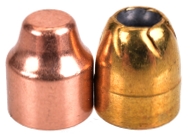 The 185 Golden Saber selection came after years of pulling bullets from ballistic gel and game. I found that short barrel 45 Autos sometimes caused hollow point bullets to barely expand and over penetrate. Golden Sabers reliably expand up to 2x shank diameter and shed very little weight. Additionally, they deliver good accuracy when properly loaded and a generate a bit more velocity because of their bore friction reducing driving band construction.
The 185 Golden Saber selection came after years of pulling bullets from ballistic gel and game. I found that short barrel 45 Autos sometimes caused hollow point bullets to barely expand and over penetrate. Golden Sabers reliably expand up to 2x shank diameter and shed very little weight. Additionally, they deliver good accuracy when properly loaded and a generate a bit more velocity because of their bore friction reducing driving band construction.
Muzzle blast, muzzle flash and loud noise to follow…
After being rained out for a few days… maybe a week, we were finally able to get in some range time and collect performance data on the R1 Carry Commander for both factory ammunition and handloads. For folks who have a general problem with autoloaders jamming or failing to feed, they might want to check their grip before looking at the pistol. Days past, if a customer brought in a 45 Auto and complained of failure to feed, a gunsmith would see if the problem could be duplicated. These days, a person just runs to a gun board to blame a popular firearm for what is potentially their own problem. A loose shooter’s grip on a 1911 dampens slide movement can cause a cycling failure.
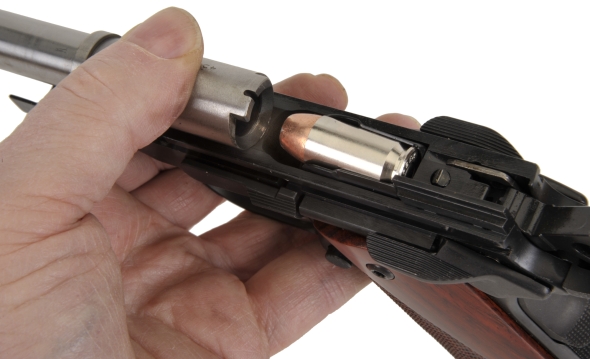
In the case of the R1, there is no extended feed ramp from the barrel, only the feed ramp at the edge of the barrel and the top radius of the magazine well. The flat follower magazines supplied with the R1 Carry Commander raises the this dummy round higher relative to bore centerline and the tapered magazine lips release the fed round sooner. Subsequently, contact between barrel and bullet is low on the nose radius of the bullet and high on the bullet feed ramp which assures reliable feed with semi wad cutter and hollow nose bullets.
Why am I bringing this issue up? Because as soon as this article is published, a dozen inexperienced or untrained shooters will commence to report that semi wad cutters jam in all 1911 type pistols and that this and similar pistols will not feed hollow point rounds without being smoked over by an obliging gunsmith… who will gladly take their money. In fact, while the R1’s manual very specifically states that the pistol is designed for standard pressure “.45 Auto 230 Grain Metal Jacket 835 FPS” ammunition, the R1 Carry Commander did not skip a beat with any of the factory ammunition or handloads it was fed, including when fed from magazines of mixed ammo types. The same applies to every other R1 type we have reviewed.
 |
Warning: Bullet selections are specific, and loads are not valid with substitutions of different bullets of the same weight. Variations in bullet length will alter net case capacity, pressure and velocity. Primer selection is specific and primer types are not interchangeable. These are maximum loads in my firearms and may easily be excessive in others. All loads should be reduced by 5%, and developed following safe handloading practices as represented in established reloading manuals produced by component manufacturers. Presentation of these loads does not constitute a solicitation for their use, nor a recommendation.
|
|||||||||||||||||||||||||||||||||||||||||||||||||||||||||||||||||||||||||||||||||
|
||||||||||||||||||||||||||||||||||||||||||||||||||||||||||||||||||||||||||||||||||
Below, the best and worst of the handload groups. Shot rested, they are a better indication of the pistols accuracy than mine. For me that is a solid result and the light target loads are easy enough shooting to allow for extended range sessions and practice.
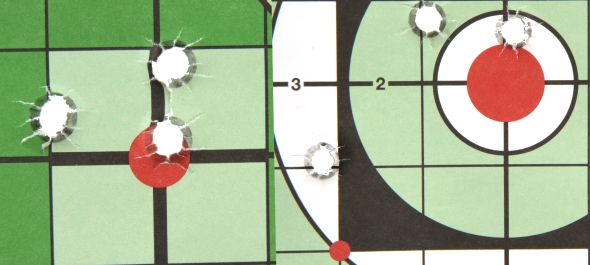
Factory fresh…
I selected the cartridges below as a small sample of what is available for the .45 Auto, from low penetration aluminum clad poly filled bullets to something very close to U.S. Ball ammo and some high performance defensive loads in between. The Hornady +P is out of spec for the pistol and was tested after a recoil spring change.
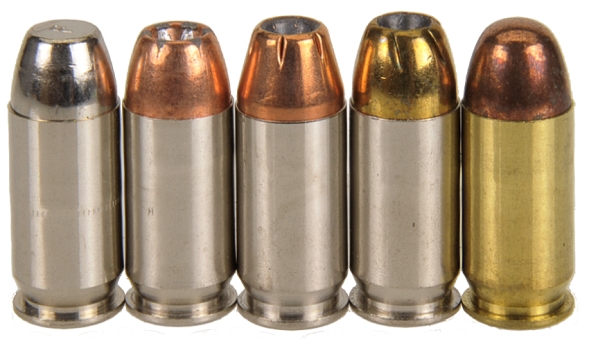
| Factory Ammunition | Bullet Weight |
5.00″ Barrel Rated MV FPS |
4.25″ Barrel Recorded MV FPS |
Rested 3 Shot Group Inches |
| Federal Guard Dog | 165 | 1140 | 994 | 2.8 |
| Speer Gold Dot | 185 | 1050 | 972 | 2.4 |
| Hornady +P HP/XTP | 200 | 1055 | 1000 | 3.0 |
| Remington Ultimate H D | 230 | 875 | 841 | 2.6 |
| Remington UMC FMJ | 230 | 835 | 797 | 3.2 |
Again, factory ammo performance is solid for a defensive weapon and accuracy and velocity was consistent. The pistol is very well made and I am sure it would respond to the typical pokes and tweaks that improve accuracy, without reducing reliability. And, again, no failures to cycle and feed.
Before moving on to other things…
The Remington R1 Carry Commander is best described as a U.S. made, premium quality, 1911 type pistol. More than a basic pistol, it has many features found mostly on significantly higher priced guns and could easily be pressed into service as is. It is not a bullseye pistol, it is a good defensive gun, scaled back a bit to Commander length to better facilitate concealed carry.
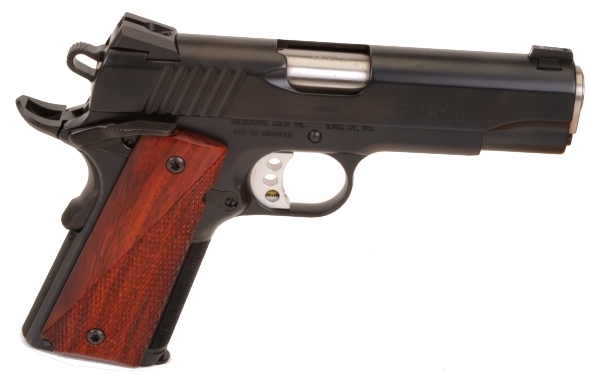
If I purchased this R1 for my personal use I would leave it alone, with the possible exception of sights. I like fiber optic, but knowing that the R1 takes Novak standard, I know they are available from a number of manufacturers. It doesn’t need accessories, it doesn’t need a trigger job or other work to make it reliable as it is reliable right out of the box. I would also say that it isn’t for everyone. The 45 Auto is a serious round, the R1 Carry has a lot of bark and a 1911 requires practice to build proficiency. The ability to shoot this firearm well is not an issue of stature or strength, it is an issue of technique. As an example, my wife is petite, but can shoot cloverleaves with a 45 Auto. I am a 1911 fan, so there are always a few around. This one happens to be a very good one.
Remington’s Model 1911 Carry Commander Part 1
Remington’s Model 1911 Carry Commander Part 2

Email Notification